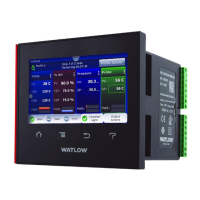Watlow F4T • 84 • Chapter 5 Function Reference
Off
When Type is set to Off, the output is off.
Process Alarm
A Process Alarm sets its output when the receiver (IN) rises above the High Set Point or drops
below the Low Set Point. The alarm’s behavior can be customized with Logic, Latching, Block-
ing, Silencing and Delay Time parameters.
Signals
Direction Label Type Function
Receivers
IN Analog Monitored for alarm conditions
Not used
SIL Digital True silences the alarm (see Silencing)
CLR Digital
True clears the alarm if the condition that caused it no lon-
ger exists (See Latching)
OFF Digital True makes the function act as if Alarm Type was set to off
Transmitter - - - - Digital Indicates the alarm state (see Logic)
Name
Uniquely identify this FB using up to 20 alphanumeric characters.
Type
To monitor an analog signal for alarm conditions, set Type to Process Alarm.
Sides
Select whether the receiver (IN) is monitored for high, low or both high and low alarms.
Options:
• Both: IN is monitored for high, low or both high and low alarms.
• High: IN is monitored for a high alarm only. The low alarm is not monitored.
• Low: IN is monitored for a low alarm only. The high alarm is not monitored.
Hysteresis
Set how far the process must return into the normal range before the alarm can be cleared.
Hysteresis defines how far the signal must drop below the High Alarm Set Point before a high
alarm can be cleared and how far the signal must rise above the Low Alarm Set Point before
a low alarm can be cleared.
Range: 1 to 9,999 °F or units
2 to 5,555 °C

